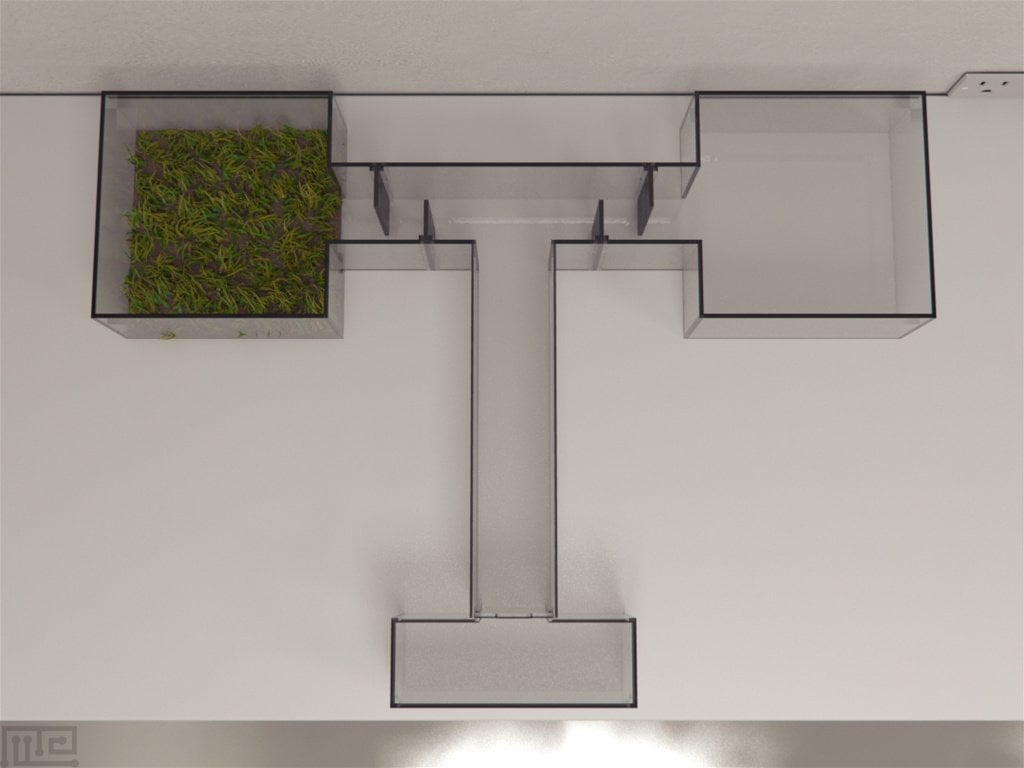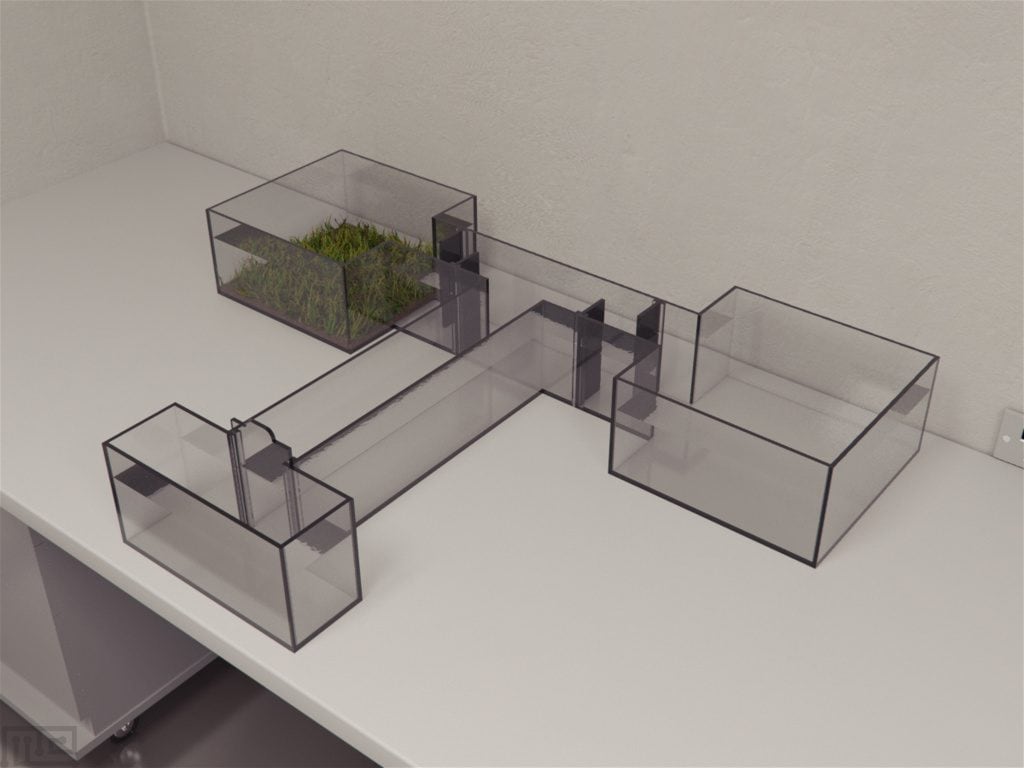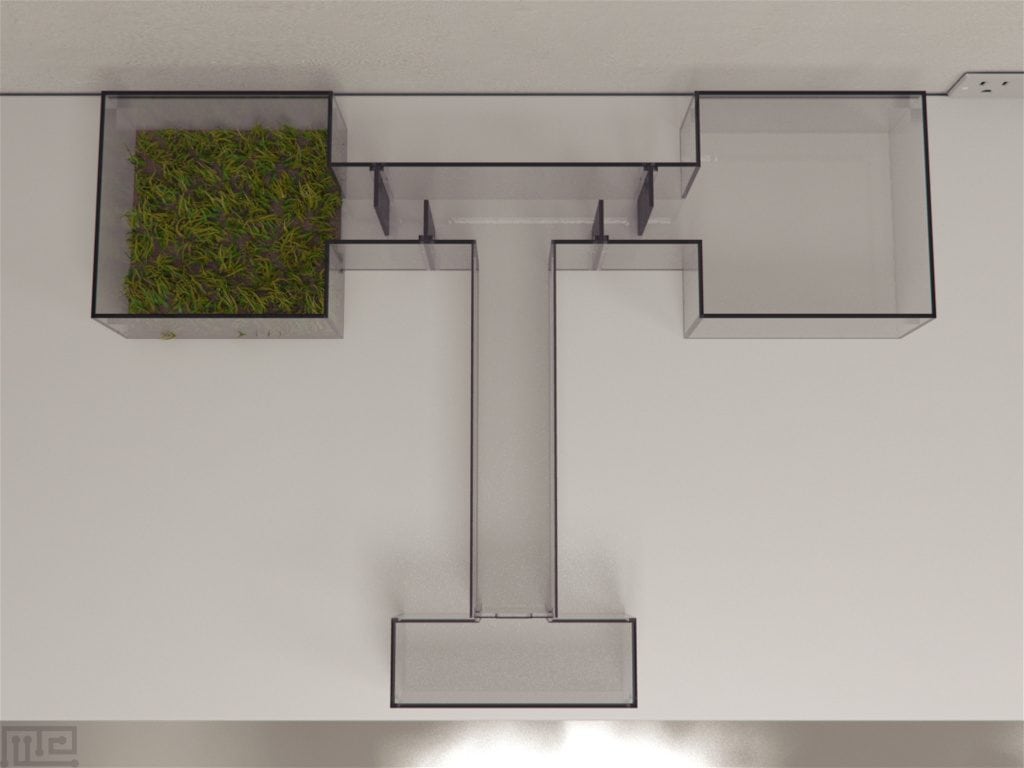Description
The Zebrafish bifurcating T maze has been described in the literature as a screening test for the role of nicotinic acetylcholine receptors in Zebrafish. It has been traditionally used as a screening maze, but can also be used for choice and learning experiments.
Price & Dimensions
Zebrafish Bifurcating T Maze
$ 2900
Per Month- Starting zone (30 cm×10 cmx15 cm) separated from the rest of
the maze by a transparent removable door. - Long (50 cm×10 cm) arm
- Two short (20 cm×10 cm) arms
- Two removable opaque partitions (4.5 cm×30 cm) for each short arm
- Removable deep water chambers (30 cm×30 cm x 30cm)
- One of two chambers, used as reservoir, contained artificial grass, shells, stones and coloured marbles that offered a favourable
habitat for the fish. These supplies are not included.
Documentation
Introduction
The Zebrafish Bifurcating T-Maze is often used as a behavioral screening test. The maze is an adaptation of the conventional T-Maze used in the assessment of spatial learning and memory. Just like the conventional T-Maze, the Zebrafish Bifurcating T-Maze also provides the subject with two choices. The aquatic maze usually uses deep water chambers at the ends of the choice arm of which one is designed to provide a more favorable environment. Opaque partitions are usually used to block the views of these chambers to prevent influence on the maze performance. The T-Maze is useful in the evaluation of the effects of drugs, aging, and anxiety on cognition and other behavioral performances.
Among non-vertebrate models, the Zebrafish are evolutionarily closer to humans. Their genetic similarity to humans and the availability of forward genetic phenotype screening make them ideal for research. Further, their maintenance and housing are much easier than other animal models. In the Zebrafish Bifurcating T-Maze, the drug or non-drug treated fish is tested for their ability to learn and remember the arm that leads to the favorable environment. The simple test allows rapid assessment of the cognitive and memory phenotypes.
Other apparatus that use the zebrafish model include the Zebrafish Y-maze, the Zebrafish Three Chamber Choice, and the Zebrafish Place Preference Test. (For more Zebrafish testing apparatus and equipment click here).
Apparatus & Equipment
The Zebrafish Bifurcating T-maze is an acrylic aquatic tank shaped like a capital ‘T.’ The long start arm (50 x 10 cm) bifurcates into two shorter choice arms (20 x 10 cm). The start arm has a 30 x 10 cm start zone that is separated from the rest of the maze by a removable transparent door. The ends of each choice arm are equipped with removable, deep water chambers of dimension 30 x 30 cm. Either of the chambers can be turned into a reservoir by addition of artificial grass, colored marbles, etc. Additionally, a 4.5 x 30 cm removable, opaque partitions can be placed beginning of the short arms to prevent viewing of the two chambers.
Training Protocol
The subjects should be housed in tanks that are maintained at a constant temperature and pH value. It is advisable that these conditions be maintained throughout the sessions to avoid unnecessary harm or stress to the fish. It is also important to keep the water aerated and the quality of water maintained at an acceptable level. Automated tracking and video software, such as the Noldus Ethovision XT, placed on the ceiling above the tank allows tracking and recording of the behaviors and movements of the fish. Between each subject empty the tank and thoroughly rinse it before next use.
Pretraining
Prior to T-Maze trials, habituate the fishes to the environment to minimize novelty and handling stress. Allow the subjects to explore the maze for 1 hour every day on a 2-trials per day basis. Perform habituation trials for at least 3 days starting with a large group and gradually reducing the group size as the days progress. Gradual reduction of group sizes during habituation training reduces acute social stress when the subject performs the T-Maze task individually.
T-Maze Training
Begin the training session by isolating the fish in the start zone tank for 5 minutes. Open the door of the start tank after the 5 minutes have elapsed, and close it once the subject has entered the start arm. Allow the subject at least 5 to 10 minutes to reach either of the choice chambers. Once the subject has reached a chamber, let it stay in it for at least 20 seconds before placing it back in its home tank. Perform a second trial after 3 hours. Perform a final trial after 24 hours have passed.
Investigation of the role of nAChRs in learning and memory
The effect of nicotine (NIC), cytisine (CYT) and cytisine-derived partial agonists CC4 and CC26 on spatial memory were evaluated using the Zebrafish Bifurcating T-maze task. Further, using selective neuronal nicotinic acetylcholine receptors (nAChR) antagonists the role of α4/α6β2 and the α7 nAChRs in NIC-induced memory enhancement was also evaluated. Adult short-finned wild-type zebrafish were administered the drugs via injections 10 minutes prior to the probe trials. It was observed that NIC, CYT, CC4, and CC26 increased and decreased spatial memory performance following an inverted U-shaped dose-response curve. Further, all the partial agonists blocked the cognitive enhancement. (Braida et al., 2014)
Data Analysis
The data collected from the Zebrafish Bifurcating T-Maze can include
- Time spent in each arm
- Total distance
- Mean speed
- Turn angle
- Running time
Strengths & Limitations
Strengths
The Zebrafish Bifurcating T-Maze is an adaption of the successful conventional T-Maze used in the assessment of learning and memory. The apparatus is simple, inexpensive and easy to construct. The clear apparatus allows visualization of the subjects as they perform in the maze. The removable chambers at the ends of the choice arms allow easy adaptation of the maze for other investigations. Further, these end chambers allow researchers to create different environments that either favorable or unfavorable to the fish to test different paradigms. The opaque staggered barriers enable blocking the view of the environment to prevent the environments from influencing the choice of the fish. The start box allows the introduction of start delays. The T-Maze task is ideal for as a behavioral screening test to evaluate the pharmacological responses of the fishes. The task can also be used in the assessment of hippocampal functions, age-related cognitive decline, anxiety, and conditional-learning.
Limitations
The T-Maze is a single-point two-choice maze thus it has a higher rate of success possibility as the probability of the subject choosing the correct arm is by default 50%. The performance of the fishes may be affected by disturbing external stimuli such as noise, vibration, and visual stimuli. Handling, habituation and rearing environments can also have an impact on the performance. Undue stress and anxiety can result in incorrect results and observations. It is vital to maintain constant tank temperature and other environmental factors during the test to avoid unnecessary influences on the performances. Care should also be taken to consider the health of the fishes.
Summary & Key Points
- Zebrafish Bifurcating T-Maze task is simple, rapid and inexpensive.
- Zebrafish Bifurcating T-Maze is extensively used as a behavioral screening test.
- Zebrafish Bifurcating T-Maze can be used in the study of hippocampal functions, age-related cognitive decline, and
- The start zone allows the introduction of start delays.
- The removable choice arm chambers can be set-up to create favorable or unfavorable environments.
- Zebrafish serve as an ideal organism model due to their similar genetic structure to humans and their genetic tractability and the availability of forward genetic phenotype screening.
References
Braida, D., Ponzoni, L., Martucci, R., Sparatore, F., Gotti, C., &Sala, M. (2014). Role of neuronal nicotinic acetylcholine receptors (nAChRs) on learning and memory in zebrafish. Pschopharmacology, 231 (9), 1975-85.
Yu L, Tucci V, Kishi S, Zhdanova IV (2006). Cognitive aging in zebrafish. PLoS One. 1:e14.




